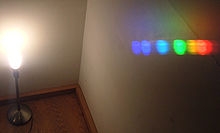We’ve been talking about color and light. Color shift is mentioned here quite often. I would like to examine how the two relate. The gem does not actually shift color – it’s chemical composition doesn’t change – it’s the light that hits the gem and is returned to our eyes that changes.
Originally, one had only sunlight by which to see and judge a gem. Then sunlight and fluid or fat lamps. Then gaslight was added. Then incandescent and fluorescent. Now we have LCD, LED and new generations of light coming along.
So, if we hold by the notion that some promote that gems “should” hold their color in current lights – assuming this means incandescent and fluorescent as well as sunlight – what happens to the “value” of those stones as those sources are fazed out of use (incandescent for sure) and the colors appear different in the new lighting sources.
Does this crash the market? Do we start with new values?
Or does it really rely on the color of gems in sunlight?
Originally, one had only sunlight by which to see and judge a gem. Then sunlight and fluid or fat lamps. Then gaslight was added. Then incandescent and fluorescent. Now we have LCD, LED and new generations of light coming along.
So, if we hold by the notion that some promote that gems “should” hold their color in current lights – assuming this means incandescent and fluorescent as well as sunlight – what happens to the “value” of those stones as those sources are fazed out of use (incandescent for sure) and the colors appear different in the new lighting sources.
Does this crash the market? Do we start with new values?
Or does it really rely on the color of gems in sunlight?





![incasun[1].jpg incasun[1].jpg](https://www.pricescope.com/community/data/attachments/270/270504-9ea688fd91e45630ad76dd81996cd4ab.jpg?hash=nqaI_ZHkVj)



300x240.png)